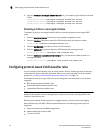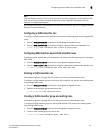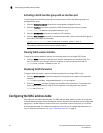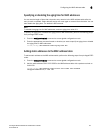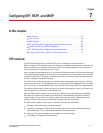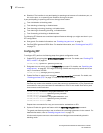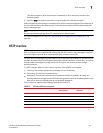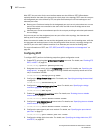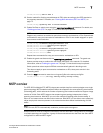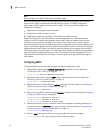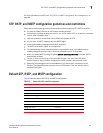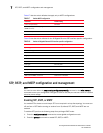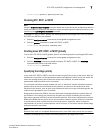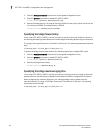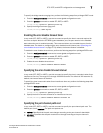60 Converged Enhanced Ethernet Administrator’s Guide
53-1002163-02
RSTP overview
7
DRAFT: BROCADE CONFIDENTIAL
With RSTP, the port roles for the new interface states are also different. RSTP differentiates
explicitly between the state of the port and the role it plays in the topology. RSTP uses the root port
and designated port roles defined by STP, but splits the blocked port role into backup port and
alternate port roles:
• Backup port—Provides a backup for the designated port and can only exist where two or more
ports of the switch are connected to the same LAN; the LAN where the bridge serves as a
designated switch.
• Alternate port—Serves as an alternate port for the root port providing a redundant path towards
the root bridge.
Only the root port and the designated ports are part of the active topology; the alternate and
backup ports do not participate in it.
When the network is stable, the root and the designated ports are in the forwarding state, while the
the alternate and backup ports are in the discarding state. When there is a topology change, the
new RSTP port roles allow a faster transition of an alternate port into the forwarding state.
For more information on RSTP, see “STP, RSTP, and MSTP configuration and management” on
page 64.
Configuring RSTP
To configure RSTP, perform the following steps from global configuration mode.
1. Enable RSTP using the global protocol spanning-tree command. For details, see “Enabling STP,
RSTP, or MSTP” on page 64.
switch(config)#protocol spanning-tree rstp
2. Designate the root switch using the bridge-priority command. For details, see “Specifying the
bridge priority” on page 65. The range is 0 through 61440 and the priority values can be set
only in increments of 4096.
switch(conf-rstp)#bridge-priority 28672
3. Configure the bridge forward delay value. For details, see “Specifying the bridge forward delay”
on page 66.
switch(conf-rstp)#forward-delay 20
4. Configure the bridge maximum aging time value. For details, see “Specifying the bridge
maximum aging time” on page 66.
switch(conf-rstp)#max-age 25
5. Enable the error disable timeout timer value. For details, see “Enabling the error disable
timeout timer” on page 67.
switch(conf-rstp)#error-disable-timeout enable
6. Configure the error-disable-timeout interval value. For details, see “Specifying the error disable
timeout interval” on page 67.
7. switch(conf-rstp)#error-disable-timeout interval 60
8. Configure the port-channel path cost method. For details, see “Specifying the port-channel
path cost” on page 67.
switch(conf-rstp)#port-channel path-cost custom
9. Configure the bridge hello time value. For details, see “Specifying the bridge hello time (STP
and RSTP)” on page 68.



